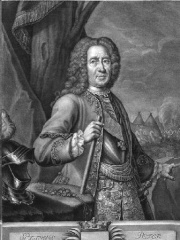
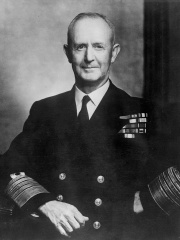
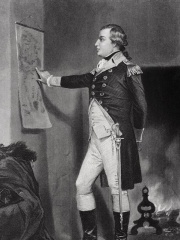
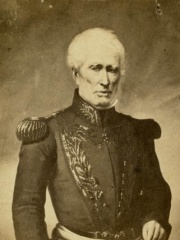
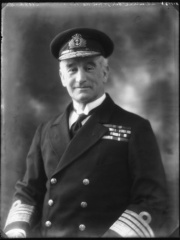
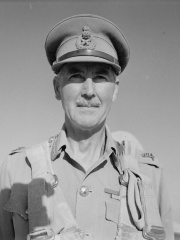
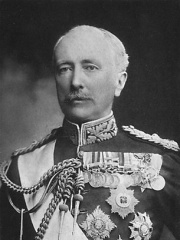
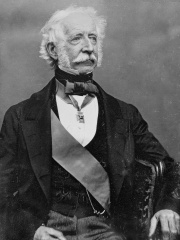
The Most Famous
MILITARY PERSONNELS from Ireland
This page contains a list of the greatest Irish Military Personnels. The pantheon dataset contains 2,058 Military Personnels, 10 of which were born in Ireland. This makes Ireland the birth place of the 27th most number of Military Personnels behind Bulgaria, and Belgium.
Top 10
The following people are considered by Pantheon to be the top 10 most legendary Irish Military Personnels of all time. This list of famous Irish Military Personnels is sorted by HPI (Historical Popularity Index), a metric that aggregates information on a biography's online popularity. Visit the rankings page to view the entire list of Irish Military Personnels.

1. Peter Lacy (1678 - 1751)
With an HPI of 62.71, Peter Lacy is the most famous Irish Military Personnel. His biography has been translated into 21 different languages on wikipedia.
Peter Graf von Lacy (26 September 1678 – 30 April 1751) was an Irish-born soldier who later served in the Imperial Russian Army. Considered one of the most successful Russian commanders before Rumyantsev and Suvorov, in a military career that spanned half a century he claimed to have participated in 31 campaigns, 18 battles, and 18 sieges. He died on his private estate in Riga, where he served as governor for many years. His remains were buried in the crypt of the Catholic church in Skaistkalne, in southern Latvia. One of his sons was Count Franz Moritz von Lacy, who went on to serve in the Imperial Habsburg Army, while his nephew George Browne (1698–1792) was also a general in the Russian army.

2. Andrew Cunningham, 1st Viscount Cunningham of Hyndhope (1883 - 1963)
With an HPI of 62.49, Andrew Cunningham, 1st Viscount Cunningham of Hyndhope is the 2nd most famous Irish Military Personnel. His biography has been translated into 31 different languages.
Admiral of the Fleet Andrew Browne Cunningham, 1st Viscount Cunningham of Hyndhope, (7 January 1883 – 12 June 1963) was a Royal Navy officer best known for his service during World War II. He was widely known by his initials, "ABC". Cunningham was born in Rathmines in the south side of Dublin on 7 January 1883. After starting his schooling in Dublin and Edinburgh, he enrolled at Stubbington House School, at the age of ten. He joined the Royal Navy in 1897 as a naval cadet in the officers' training ship Britannia, passing out in 1898. He commanded a destroyer during World War I and through most of the interwar period. He was awarded the Distinguished Service Order and two Bars, for his performance during this time, specifically for his actions in the Dardanelles and in the Baltics. In the Second World War, as Commander-in-Chief, Mediterranean Fleet, Cunningham led British naval forces to victory in several critical Mediterranean naval battles. These included the attack on Taranto in 1940, the first completely all-aircraft naval attack in history, and the Battle of Cape Matapan in 1941. Cunningham controlled the defence of the Mediterranean supply lines through Alexandria, Gibraltar, and the key chokepoint of Malta. He also directed naval support for the various major Allied landings in the Western Mediterranean littoral. In autumn 1943, on the death of the incumbent, Sir Dudley Pound, Cunningham was promoted to First Sea Lord, the professional head of the Royal Navy, a position he held until his retirement in 1946. He was ennobled as Baron Cunningham of Hyndhope in 1945 and made Viscount Cunningham of Hyndhope the following year. After his retirement, Cunningham enjoyed several ceremonial positions, including Lord High Steward at the coronation of Queen Elizabeth II in 1953. He died on 12 June 1963, aged 80.

3. Richard Montgomery (1738 - 1775)
With an HPI of 60.77, Richard Montgomery is the 3rd most famous Irish Military Personnel. His biography has been translated into 21 different languages.
Richard Montgomery (2 December 1738 – 31 December 1775) was an Irish-born American army officer. First serving in the British Army, he later became a major general in the Continental Army during the American Revolutionary War. On 31 December 1775, Montgomery was killed while leading an unsuccessful invasion of Quebec. Montgomery was born and raised in Ireland to an Ulster-Scots family. In 1754, he enrolled at Trinity College Dublin, and two years later joined the British army and served in the French and Indian War. He steadily rose through the ranks, serving in North America and the West Indies. After the war he was stationed at Fort Detroit during Pontiac's War, following which he returned to Britain for health reasons. In 1773, Montgomery returned to the Thirteen Colonies, married Janet Livingston, and began farming. When the Revolutionary War broke out, Montgomery joined the Patriot cause, and was elected to the New York Provincial Congress in May 1775. In June 1775, he was commissioned as a brigadier general in the Continental Army. After Philip Schuyler became too ill to lead the invasion of Quebec, Montgomery took over. He captured Fort St. Jean and Montreal in November 1775, and then advanced to Quebec City, where he joined another force under the command of Benedict Arnold. On 31 December, he led an attack on the city, but was killed during the battle. The British found his body and gave him an honorable burial. His remains were moved to New York City in 1818.

4. William Brown (1777 - 1857)
With an HPI of 60.74, William Brown is the 4th most famous Irish Military Personnel. His biography has been translated into 22 different languages.
William Brown (also known in Spanish as Guillermo Brown or Almirante Brown) (22 June 1777 – 3 March 1857) was an Irish sailor, merchant, and naval commander who served in the Argentine Navy during the wars of the early 19th century. Brown's successes in the Argentine War of Independence, the Cisplatine War, and the Anglo-French blockade of the Río de la Plata earned the respect and appreciation of the Argentine people, and he is regarded as one of Argentina's national heroes. The creator and first admiral of the country's maritime forces, he is commonly known as the "father of the Argentine Navy".
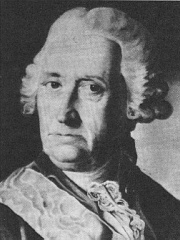
5. George Browne (1698 - 1792)
With an HPI of 59.87, George Browne is the 5th most famous Irish Military Personnel. His biography has been translated into 18 different languages.
George Browne (Russian: Юрий Юрьевич Броун, romanized: Yury Yuryevich Broun; Irish: Seoirse de Brún; German: Georg Reichsgraf von Browne, French: Georges de Browne), known as Count von Browne in the nobility of the Holy Roman Empire (15 June 1698 – 18 February 1792), was an Irish soldier of fortune who became full general in the Russian service.

6. John de Robeck (1862 - 1928)
With an HPI of 57.97, John de Robeck is the 6th most famous Irish Military Personnel. His biography has been translated into 17 different languages.
Admiral of the Fleet Sir John Michael de Robeck, 1st Baronet, (10 June 1862 – 20 January 1928) was an officer in the Royal Navy. In the early years of the 20th century he served as Admiral of Patrols, commanding four flotillas of destroyers. De Robeck commanded the allied naval force in the Dardanelles during the First World War. His campaign to force the straits, launched on 18 March 1915, was nearly successful, as the Turkish land-based artillery almost ran out of ammunition. However, mines laid in the straits led to the loss of three allied battleships. The subsequent ground campaign, like the naval campaign, was ultimately a failure and the ground troops had to be taken off the Gallipoli peninsula by de Robeck on the night of 8 January 1916. He went on to become Commander of the 3rd Battle Squadron of the Grand Fleet and then Commander of the 2nd Battle Squadron of the Grand Fleet. After the war de Robeck became Commander-in-Chief of the Mediterranean Fleet and British High Commissioner to Turkey, and then Commander-in-Chief of the Atlantic Fleet.

7. Alan Cunningham (1887 - 1983)
With an HPI of 57.93, Alan Cunningham is the 7th most famous Irish Military Personnel. His biography has been translated into 20 different languages.
Sir Alan Gordon Cunningham, (1 May 1887 – 30 January 1983), was a senior officer of the British Army noted for his victories over Italian forces in the East African Campaign during the Second World War. He then commanded Eighth Army in the desert campaign, but was relieved of command during the Crusader battle against Erwin Rommel. Later he served as the seventh and last High Commissioner of Palestine. He was the younger brother of Admiral of the Fleet Lord Cunningham of Hyndhope.

8. Garnet Wolseley, 1st Viscount Wolseley (1833 - 1913)
With an HPI of 57.06, Garnet Wolseley, 1st Viscount Wolseley is the 8th most famous Irish Military Personnel. His biography has been translated into 21 different languages.
Field Marshal Garnet Joseph Wolseley, 1st Viscount Wolseley (4 June 1833 – 25 March 1913) was an Anglo-Irish officer in the British Army. He became one of the most influential British generals after a series of victories in Canada, West Africa and Egypt, followed by a central role in modernizing the British Army in promoting efficiency. Wolseley is considered to be one of the most prominent and decorated war heroes of the British Empire during the era of New Imperialism. He served in Burma, the Crimean War, the Indian Mutiny, China, Canada and widely throughout Africa—including his Ashanti campaign (1873–1874) and the Nile Expedition against Mahdist Sudan in 1884–85. Wolseley served as Commander-in-Chief of the Forces from 1895 to 1900. His reputation for efficiency led to the late 19th century English phrase "everything's all Sir Garnet", meaning, "All is in order."

9. Hugh Gough, 1st Viscount Gough (1779 - 1869)
With an HPI of 54.35, Hugh Gough, 1st Viscount Gough is the 9th most famous Irish Military Personnel. His biography has been translated into 16 different languages.
Field Marshal Hugh Gough, 1st Viscount Gough, (3 November 1779 – 2 March 1869) was a senior British Army officer. After serving as a junior officer at the seizure of the Cape of Good Hope during the French Revolutionary Wars, Gough commanded the 2nd Battalion of the 87th (Royal Irish Fusiliers) Regiment of Foot during the Peninsular War. After serving as commander-in-chief of the British forces in China during the First Opium War, he became Commander-in-Chief, India and led the British forces in action against the Marathas defeating them decisively at the conclusion of the Gwalior campaign and then commanded the troops that defeated the Sikhs during both the First Anglo-Sikh War and the Second Anglo-Sikh War.
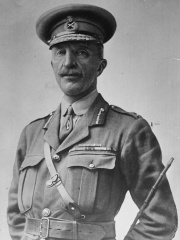
10. Sir Henry Wilson, 1st Baronet (1864 - 1922)
With an HPI of 51.25, Sir Henry Wilson, 1st Baronet is the 10th most famous Irish Military Personnel. His biography has been translated into 20 different languages.
Field Marshal Sir Henry Hughes Wilson, 1st Baronet (5 May 1864 – 22 June 1922) was one of the most senior British Army staff officers of the First World War and an Irish unionist politician. He served as commandant of the Staff College, Camberley, and then as Director of Military Operations at the War Office. Wilson played a vital role in drawing up plans to deploy an Expeditionary Force to France in the event of war. He acquired a reputation as a political intriguer for his role in agitating for the introduction of conscription and the Curragh incident of 1914. As Sub Chief of Staff to the British Expeditionary Force (BEF), Wilson was Sir John French's most important advisor during the 1914 campaign, but his poor relations with Douglas Haig and William Robertson saw him sidelined from top decision-making in the middle years of the war. He played an important role in Anglo-French military relations in 1915 and – after his only experience of field command as a corps commander in 1916 – as an ally of the controversial French General Robert Nivelle in early 1917. Later in 1917 he was informal military advisor to British Prime Minister David Lloyd George and then British Permanent Military Representative at the Supreme War Council at Versailles. In 1918 Wilson served as Chief of the Imperial General Staff (the professional head of the British Army). He continued to hold this position after the war, a time when the Army was being sharply reduced in size whilst attempting to contain industrial unrest in the UK and nationalist unrest in Iraq and Egypt. He also played an important role in the Irish War of Independence. After retiring from the army Wilson served briefly as a member of parliament and as security advisor to the Northern Ireland government. He was assassinated by two IRA gunmen in 1922.
People
Pantheon has 10 people classified as Irish military personnels born between 1678 and 1887. Of these 10, none of them are still alive today. The most famous deceased Irish military personnels include Peter Lacy, Andrew Cunningham, 1st Viscount Cunningham of Hyndhope, and Richard Montgomery.
Deceased Irish Military Personnels
Go to all RankingsPeter Lacy
1678 - 1751
HPI: 62.71
Andrew Cunningham, 1st Viscount Cunningham of Hyndhope
1883 - 1963
HPI: 62.49
Richard Montgomery
1738 - 1775
HPI: 60.77
William Brown
1777 - 1857
HPI: 60.74
George Browne
1698 - 1792
HPI: 59.87
John de Robeck
1862 - 1928
HPI: 57.97
Alan Cunningham
1887 - 1983
HPI: 57.93
Garnet Wolseley, 1st Viscount Wolseley
1833 - 1913
HPI: 57.06
Hugh Gough, 1st Viscount Gough
1779 - 1869
HPI: 54.35
Sir Henry Wilson, 1st Baronet
1864 - 1922
HPI: 51.25
Overlapping Lives
Which Military Personnels were alive at the same time? This visualization shows the lifespans of the 8 most globally memorable Military Personnels since 1700.

